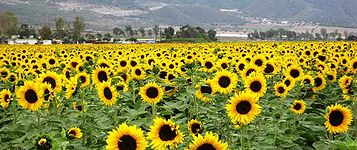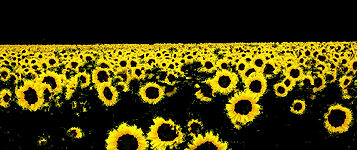Example Color Segmentation
From BoofCV
Jump to navigationJump to searchDemonstration for how an image can be segmented using color information. First the image is converted into HSV color space to add robustness against changes in lighting. Then the user selects a color and it selects pixels with a hue and saturation value and display the resulting image.
Example File: ExampleSegmentColor.java
Concepts:
- Color space
- Image segmentation
Related Examples:
Example Code
/**
* Example which demonstrates how color can be used to segment an image. The color space is converted from RGB into
* HSV. HSV separates intensity from color and allows you to search for a specific color based on two values
* independent of lighting conditions. Other color spaces are supported, such as YUV.
*
* @author Peter Abeles
*/
public class ExampleSegmentColor {
/**
* Shows a color image and allows the user to select a pixel, convert it to HSV, print
* the HSV values, and calls the function below to display similar pixels.
*/
public static void printClickedColor( final BufferedImage image ) {
ImagePanel gui = new ImagePanel(image);
gui.addMouseListener(new MouseAdapter() {
@Override
public void mouseClicked(MouseEvent e) {
float[] color = new float[3];
int rgb = image.getRGB(e.getX(),e.getY());
ColorHsv.rgbToHsv((rgb >> 16) & 0xFF,(rgb >> 8) & 0xFF , rgb&0xFF,color);
System.out.println("h = " + color[0]);
System.out.println("s = "+color[1]);
System.out.println("v = "+color[2]);
showSelectedColor("Selected",image,(float)color[0],(float)color[1]);
}
});
ShowImages.showWindow(gui,"Color Selector");
}
/**
* Selectively displays only pixels which have a similar hue and saturation values to what is provided.
* This is intended to be a simple example of color based segmentation. Color based segmentation can be done
* in RGB color, but is more problematic. More robust techniques can use Gaussian
* models.
*/
public static void showSelectedColor( String name , BufferedImage image , float hue , float saturation ) {
MultiSpectral<ImageFloat32> input = ConvertBufferedImage.convertFromMulti(image,null,ImageFloat32.class);
MultiSpectral<ImageFloat32> hsv = new MultiSpectral<ImageFloat32>(ImageFloat32.class,input.width,input.height,3);
// Ensure the the bands are in RGB order
ConvertBufferedImage.orderBandsIntoRGB(input,image);
// Convert into HSV
ColorHsv.rgbToHsv_F32(input,hsv);
// Pixels which are more than this different from the selected color are set to black
float maxDist2 = 0.4f*0.4f;
// Extract hue and saturation bands which are independent of intensity
ImageFloat32 H = hsv.getBand(0);
ImageFloat32 S = hsv.getBand(1);
// Adjust the relative importance of Hue and Saturation
float adjustUnits = (float)(Math.PI/2.0);
// step through each pixel and mark how close it is to the selected color
BufferedImage output = new BufferedImage(input.width,input.height,BufferedImage.TYPE_INT_RGB);
for( int y = 0; y < hsv.height; y++ ) {
for( int x = 0; x < hsv.width; x++ ) {
// remember Hue is an angle in radians, so simple subtraction doesn't work
float dh = UtilAngle.dist(H.unsafe_get(x,y),hue);
float ds = (S.unsafe_get(x,y)-saturation)*adjustUnits;
// this distance measure is a bit naive, but good enough for this demonstration
float dist2 = dh*dh + ds*ds;
if( dist2 <= maxDist2 ) {
output.setRGB(x,y,image.getRGB(x,y));
}
}
}
ShowImages.showWindow(output,"Showing "+name);
}
public static void main( String args[] ) {
BufferedImage image = UtilImageIO.loadImage("../data/applet/sunflowers.jpg");
// Let the user select a color
printClickedColor(image);
// Display pre-selected colors
showSelectedColor("Yellow",image,1f,1f);
showSelectedColor("Green",image,1.5f,0.65f);
}
}

